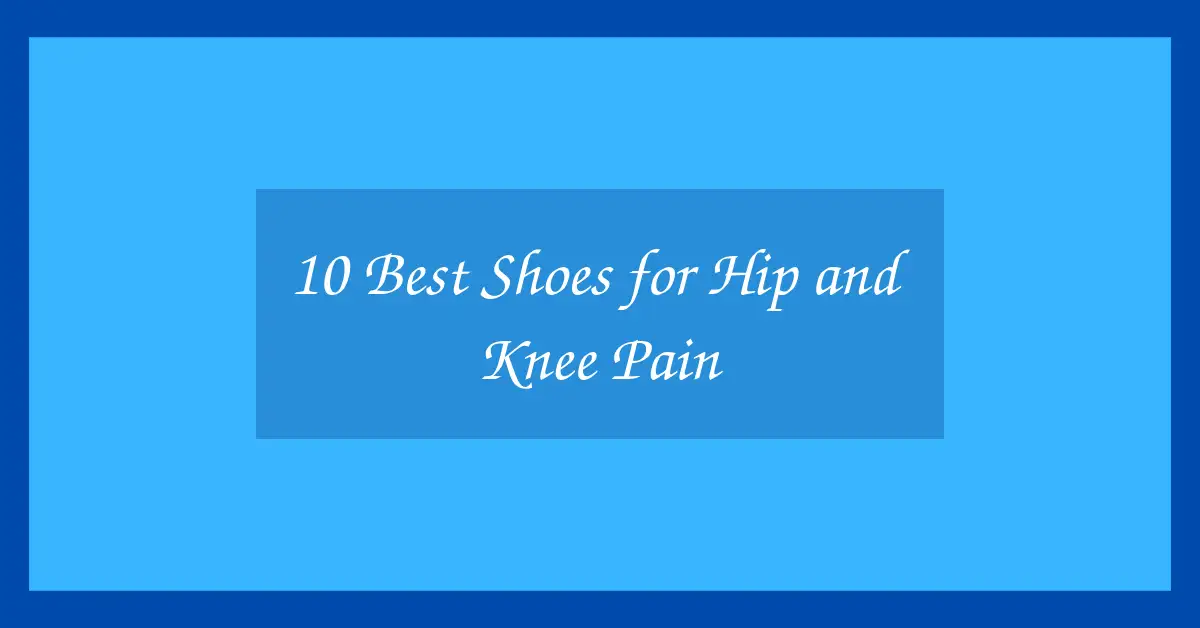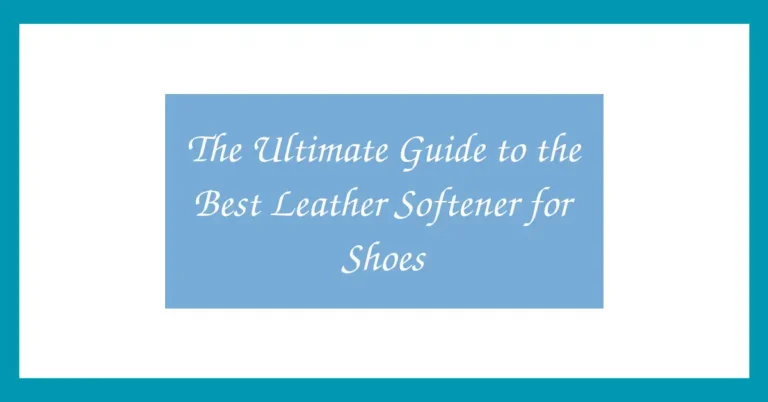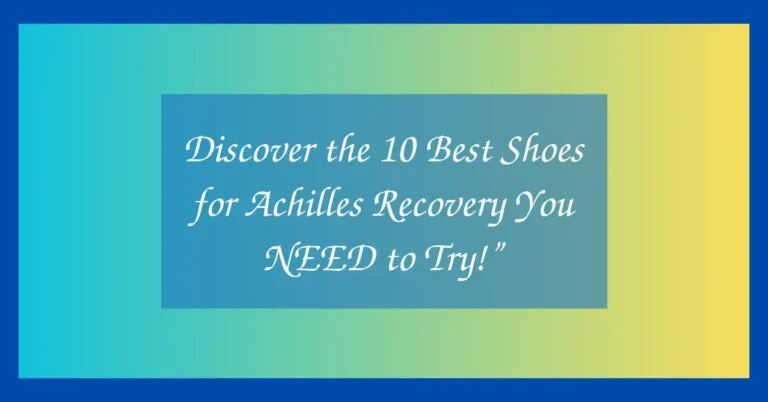10 Best Shoes for Hip and Knee Pain
Living with hip and knee pain can make even simple daily movements feel like a struggle, but the right footwear can offer meaningful relief. Whether the pain stems from arthritis, an old injury, or joint degeneration, wearing supportive, shock-absorbing shoes plays a critical role in managing discomfort and preventing further damage. Poor footwear can worsen joint misalignment, increase pressure on sensitive areas, and ultimately contribute to poor posture or gait imbalances. On the other hand, the best shoes for hip and knee pain promote better body mechanics, reduce impact during walking or standing, and support long-term joint health. In this guide, we’ll walk you through how to choose effective footwear and review the most commonly asked questions to help you make a confident, pain-reducing purchase.
Best Shoes for Hip and Knee Pain
1. Hoka Bondi 8
The Hoka Bondi 8 is one of the most cushioned shoes in Hoka’s lineup, making it an ideal choice for individuals with chronic hip and knee pain. Designed with maximum underfoot cushioning, the shoe incorporates a full-length EVA midsole that effectively absorbs shock and reduces pressure during every step. It also features a wide base that enhances stability, making it easier to maintain proper alignment during walks or long hours of standing.
One of the standout features of the Bondi 8 is its early-stage Meta-Rocker sole. This design promotes a smooth heel-to-toe transition and helps propel the foot forward without putting strain on the joints. The rocker geometry is particularly beneficial for people who suffer from osteoarthritis or stiffness in the knees and hips. It encourages a rolling motion, reducing impact during push-off and easing mobility.
The engineered mesh upper provides excellent breathability and a roomy toe box to prevent pressure build-up in the forefoot. Combined with the padded tongue and collar, the overall comfort is top-tier. Hoka has also improved the heel structure in the Bondi 8, which adds even more cushioning and support around the Achilles tendon and ankle.
Despite its bulkier appearance, the Bondi 8 remains surprisingly lightweight. The combination of plush cushioning, rocker sole, and support-focused design makes this shoe a solid daily walker for joint health. It’s also available in wide sizes, ensuring a better fit for those with specific foot shapes.
Pros:
-
Plush, full-length EVA midsole for maximum cushioning
-
Meta-Rocker sole reduces joint impact
-
Wide and stable base supports proper alignment
-
Roomy toe box and breathable upper
-
Lightweight despite its maximalist design
Cons:
-
Bulky appearance
-
Less responsive for fast-paced activities
-
Higher price point
Table of Contents
Toggle2. Brooks Addiction Walker 2
The Brooks Addiction Walker 2 is a stability walking shoe built for all-day support, making it an excellent choice for those dealing with hip and knee discomfort. It features Brooks’ Extended Progressive Diagonal Rollbar (PDRB), a support system that guides the body into its natural motion path, ideal for overpronators and those with misaligned gait patterns. This helps prevent further stress on the joints.
The shoe’s BioMoGo DNA cushioning adapts to your stride and body weight, absorbing shock and softening impact from heel to toe. This cushioning technology is especially helpful for people who are on their feet all day, distributing pressure evenly and reducing strain on painful joints. The firm midsole also provides great arch support, crucial for maintaining lower body alignment.
Durability is another strong point. The full-grain leather upper adds structure and longevity to the shoe, while also making it suitable for casual or workplace environments. It is also slip-resistant, providing solid traction on a variety of surfaces—ideal for users who may have balance or mobility issues.
Fit-wise, the Addiction Walker 2 is designed for comfort, with a padded tongue, collar, and removable insole that accommodates orthotics. It’s available in multiple widths, making it an inclusive option for people with narrow or wide feet. The fit is secure but roomy enough to avoid pressure points.
This is a shoe built for those who prioritize support, stability, and long-term joint comfort over speed or agility. It may not be flashy, but it performs where it counts.
Pros:
-
Excellent motion control with PDRB system
-
Adaptive BioMoGo DNA cushioning
-
Durable leather upper for long-lasting wear
-
Slip-resistant outsole improves safety
-
Orthotic-friendly with removable insole
Cons:
-
Heavier than athletic sneakers
-
Less breathable than mesh designs
-
Conservative style may not appeal to everyone
3. New Balance 990v6
The New Balance 990v6 continues the legacy of a classic line that’s long been favored for its comfort and orthopedic benefits. Designed in the USA, this shoe combines stability, cushioning, and a timeless aesthetic that makes it versatile for both athletic and casual wear. The 990v6 is especially well-suited for those suffering from joint pain due to its combination of ENCAP midsole and FuelCell foam.
ENCAP technology uses a supportive polyurethane rim and soft EVA core to absorb impact while stabilizing the foot. Meanwhile, FuelCell foam in the forefoot gives the shoe added bounce, reducing fatigue and improving energy return. This combination is rare in supportive shoes, offering both protection and liveliness in each step.
The upper features a breathable mesh construction blended with suede overlays, enhancing both comfort and durability. A padded collar and tongue provide ankle support, reducing the chance of rolling or instability, a common issue that can aggravate hip and knee pain. The wide base and sturdy heel counter keep the foot aligned throughout the stride.
Another highlight is the availability of multiple width options, including extra-wide sizes, which is a game-changer for people with swelling or custom orthotics. The shoe also excels in walking and standing scenarios, with a rubber outsole that grips well on urban surfaces.
While on the pricier side, the 990v6 justifies the cost with its premium materials and dual-density cushioning system. It’s an investment in both comfort and long-term joint health.
Pros:
-
Dual midsole cushioning for impact absorption and bounce
-
Great stability with wide base and heel support
-
High-quality materials and USA craftsmanship
-
Multiple width options available
-
Classic design with athletic performance
Cons:
-
High price tag
-
Slightly heavier than minimalist trainers
-
Not ideal for very hot climates due to thicker upper
4. ASICS Gel-Kayano 30
The ASICS Gel-Kayano 30 blends premium stability features with plush comfort, catering specifically to those with gait issues that contribute to hip and knee pain. It’s a favorite among overpronators thanks to its 4D Guidance System, which adapts to the runner’s stride to provide balanced, responsive support throughout the gait cycle.
At the heart of the Kayano 30 is ASICS’ signature GEL cushioning in the rearfoot and forefoot, designed to absorb shock during heel strike and toe-off. This reduces the jarring motion that can exacerbate joint pain, particularly for those who walk long distances or have a history of injuries.
The midsole now uses FF BLAST™ PLUS ECO foam, providing lightweight cushioning with a softer feel underfoot. Combined with the external heel counter, this helps lock the foot in place and promotes alignment, reducing compensatory movements that strain the knees and hips.
The engineered mesh upper conforms to the foot while maintaining breathability, and the OrthoLite™ sockliner enhances step-in comfort. Fit is secure and adaptive, with enough room in the toe box for natural splay and circulation.
This model is also carbon-neutral, making it one of the most sustainable stability shoes available today. It’s a performance sneaker that doesn’t compromise on support, making it suitable for both casual wear and light jogging or fitness walking.
Pros:
-
GEL and FF BLAST™ cushioning reduce joint impact
-
4D Guidance System corrects overpronation
-
External heel counter enhances foot alignment
-
Breathable, adaptive mesh upper
-
Eco-conscious and carbon-neutral design
Cons:
-
Runs a bit narrow for some users
-
Midsole may feel too soft for those preferring firmness
-
Not ideal for high arches without extra support
5. Orthofeet Edgewater Stretch
The Orthofeet Edgewater Stretch is specifically engineered for foot and joint pain, making it a standout choice for those struggling with severe hip and knee discomfort. As part of Orthofeet’s orthopedic line, it is packed with features that cater to alignment, cushioning, and support without compromising on everyday comfort.
The shoe includes a premium orthotic insole with anatomical arch support and a gel-padded heel seat. This combination reduces heel strike pressure and keeps the foot properly aligned to minimize stress on the knees and hips. The lightweight Ergonomic-Stride™ sole adds to the comfort by facilitating a smoother walking motion.
A notable feature of the Edgewater is its stretchable, breathable upper, which accommodates a variety of foot shapes, including bunions, hammertoes, and swelling. It also helps reduce friction and pressure points ideal for sensitive or arthritic feet.
Another benefit is the extended widths and depth, allowing easy insertion of custom orthotics and offering a precise fit for wide or diabetic feet. The padded collar and non-binding design eliminate pressure around the ankle and instep, providing a relaxed and secure feel.
For those needing medical-grade footwear with day-to-day style and comfort, the Edgewater checks all the boxes. It may not be a running shoe, but it’s one of the best therapeutic options for pain relief and all-day wear.
Pros:
-
Built-in orthotic insole with arch and heel support
-
Ergonomic sole promotes smooth, joint-friendly stride
-
Stretchable upper adapts to foot shape
-
Ideal for sensitive, arthritic, or swollen feet
-
Accommodates custom orthotics
Cons:
-
More of a therapeutic shoe than an athletic one
-
Style may not appeal to younger audiences
-
Slightly expensive for casual users
6. Saucony Integrity Walker 3
The Saucony Integrity Walker 3 is a neutral walking shoe built for maximum support and everyday comfort. It’s especially suitable for individuals with hip and knee pain who need solid arch support and consistent shock absorption during walks or long hours on their feet. The design prioritizes balance and natural movement, reducing pressure on vulnerable joints.
The PWRRUN cushioning in the midsole delivers a soft yet stable ride. Unlike ultra-plush foam, PWRRUN strikes a balance between firmness and responsiveness, providing joint-friendly impact control without making the shoe feel mushy. This helps minimize overcorrection or excess compression, which can exacerbate joint misalignment and pain.
Its Walk Trac™ outsole features a non-marking rubber design with excellent grip and durability. The outsole’s design enhances gait efficiency and helps users maintain a more consistent stride, important for those with hip instability or uneven leg mechanics.
The full-grain leather upper gives the Integrity Walker 3 a structured yet comfortable fit. It’s also durable and supportive, though it can feel less breathable in hot conditions. The padded collar and tongue enhance step-in comfort and reduce ankle friction.
This model is a solid choice for those looking for a simple, orthotic-compatible walking shoe that’s supportive without being overengineered. It may not look flashy, but its performance for joint relief is dependable.
Pros:
-
PWRRUN cushioning balances softness and support
-
Walk Trac™ outsole encourages natural gait
-
Leather upper adds durability and foot structure
-
Excellent traction and stability
-
Accommodates orthotics
Cons:
-
Less breathable than mesh shoes
-
Style leans toward basic
-
Slight break-in period for full leather upper
7. OOFOS OOmg eeZee Low Shoe
The OOFOS OOmg eeZee Low Shoe is a recovery-focused slip-on that excels at reducing stress on the knees and hips. Designed with proprietary OOfoam™ technology, this shoe absorbs 37% more impact than traditional footwear foam, making it a game changer for those recovering from joint pain or surgery.
OOfoam™ is engineered to cradle the arches and reduce energy exertion in the ankles, knees, and hips. The result is less joint fatigue and smoother transitions with every step. Unlike many comfort shoes, the OOmg eeZee delivers cushioning without losing integrity over time, maintaining its shock-absorbing capabilities even after extended wear.
The upper is constructed from a breathable, stretchy mesh material that hugs the foot comfortably without any pressure points. It’s designed to expand with swelling, bunions, or wide feet, making it ideal for individuals who need a relaxed and adaptive fit.
The shoe also features a rocker-bottom design that supports the natural motion of walking. This helps reduce the load on knees and hips during the stride cycle, especially during the push-off phase. It’s a fantastic option for post-surgery patients or anyone needing a low-impact recovery shoe.
Though it’s not built for running or rugged terrain, the OOmg eeZee excels as a recovery and daily walking shoe. Its minimal style makes it easy to wear both indoors and out.
Pros:
-
OOfoam™ absorbs 37% more impact
-
Rocker bottom design promotes smoother stride
-
Lightweight and slip-on for easy use
-
Ideal for recovery and joint rehabilitation
-
Upper stretches to accommodate swelling or wide feet
Cons:
-
Limited traction for rugged terrain
-
Minimalist look may not appeal to all
-
Not suitable for athletic use
8. Altra Torin 7
The Altra Torin 7 stands out with its zero-drop platform and foot-shaped toe box—two unique features that can significantly benefit those dealing with hip and knee pain. This design promotes natural posture and alignment from the ground up, reducing compensatory stress on joints.
The Torin 7 uses Altra’s EGO™ MAX midsole foam, which is soft yet springy, providing excellent shock absorption without feeling too plush. It works especially well for people who want impact protection but also need energy return during extended walks or light runs.
Its zero-drop platform encourages midfoot striking, helping to eliminate excessive heel impact that can transmit force to the knees and hips. While this may require an adjustment period, it can lead to improved posture and a more efficient gait for many users.
The upper is engineered with lightweight mesh and a heel collar designed for anatomical comfort. It holds the foot securely without restricting movement, and the wide toe box allows natural toe splay, reducing pressure in the forefoot and improving stability.
The Torin 7 is an excellent transition shoe for those looking to improve gait mechanics naturally while relieving hip and knee discomfort. Just be cautious with the zero-drop design if you’re not used to it—gradual adaptation is key.
Pros:
-
Zero-drop platform promotes natural alignment
-
FootShape™ toe box enhances balance and stability
-
EGO™ MAX cushioning absorbs shock and adds rebound
-
Lightweight and breathable upper
-
Encourages midfoot strike to reduce knee impact
Cons:
-
Not ideal for users with tight calves or Achilles issues
-
Requires transition period for new zero-drop users
-
Less structured than motion control shoes
9. Vionic Walker Classic
The Vionic Walker Classic is a podiatrist-designed shoe that prioritizes joint alignment, making it a top contender for reducing hip and knee pain. With a firm, supportive footbed and reliable motion control features, it’s tailored for overpronators and those needing targeted gait correction.
The shoe includes Vionic’s signature Orthaheel technology, which delivers structured arch support and a deep heel cup. This helps center the foot during each step and reduces inward rolling, which can throw off alignment and strain the hips and knees. It’s especially useful for people with flat feet or plantar fasciitis alongside joint pain.
Cushioning is provided by a dual-density EVA midsole that balances support and comfort. It’s not as plush as performance runners, but it’s effective at stabilizing the foot over long periods. The durable rubber outsole adds to the overall stability and offers dependable traction on various surfaces.
The upper is made from water-resistant leather, which adds a touch of style and makes the shoe suitable for a range of conditions. Inside, the padded collar and tongue enhance comfort, while the removable insole gives users the option to insert custom orthotics.
For those who prioritize orthopedic support and alignment correction, the Vionic Walker Classic delivers medical-grade relief in a durable, everyday-friendly package.
Pros:
-
Orthaheel technology supports arch and heel alignment
-
Motion control reduces overpronation and joint stress
-
Durable and water-resistant leather upper
-
Dual-density midsole cushions and supports
-
Approved by podiatrists and APMA certified
Cons:
-
Break-in period may be needed
-
Leather upper is less breathable
-
Style leans toward orthopedic/clinical
10. Hoka Arahi 7
The Hoka Arahi 7 offers a rare blend of stability and cushioning in a lightweight package, making it an ideal choice for users who want joint-friendly support without bulk. It’s a go-to for overpronators and runners dealing with chronic hip and knee discomfort.
This shoe features Hoka’s J-Frame™ technology, which uses firmer foam along the medial side to guide the foot without using rigid posts. This design corrects overpronation gently, making it more comfortable for people who need gait correction but dislike the stiffness of traditional motion control shoes.
The Arahi 7 also includes a plush CMEVA midsole for shock absorption, combined with a flat-waisted geometry that enhances stability. Together, these features help reduce strain on the knees and hips while keeping the stride smooth and efficient.
The upper is redesigned with a new stretch knit material that offers better breathability and lockdown. It fits securely around the midfoot and heel without causing pressure, and the roomy forefoot adds comfort during long sessions of walking or standing.
If you’re looking for a supportive yet cushioned shoe that doesn’t sacrifice mobility or comfort, the Arahi 7 is an excellent choice for everyday use and light exercise.
Pros:
-
J-Frame™ supports overpronation without stiffness
-
Plush cushioning reduces impact on joints
-
Lightweight despite its stability features
-
Stretch-knit upper improves breathability and fit
-
Wide forefoot enhances comfort and stability
Cons:
-
May feel too soft for users preferring firmer support
-
Not as structured as traditional motion control shoes
-
Slightly higher price for a daily trainer
Buyer’s Guide
When selecting shoes to relieve hip and knee pain, it’s important to focus on function over fashion. Not all shoes are built to support your joints, so identifying the right features will ensure that you get the pain relief and comfort you need.
1. Arch Support
Proper arch support helps distribute weight evenly across your feet, reducing strain on your hips and knees. People with flat feet or high arches should look for shoes specifically tailored to their foot structure, as poor arch support can lead to joint misalignment and increased pain.
2. Cushioning and Shock Absorption
Shoes that feature cushioned midsoles—especially made from EVA foam, memory foam, or gel—can absorb the impact that usually travels up through the feet to the knees and hips. This is particularly important if you spend long hours on hard surfaces or walk frequently.
3. Stability and Motion Control
Motion control or stability shoes are great for those who tend to overpronate (roll their feet inward), as this can throw off alignment and exacerbate joint pain. Look for features like medial posts, firm heel counters, or dual-density midsoles to maintain alignment.
4. Lightweight Design
Heavy shoes can place unnecessary strain on joints. Lightweight shoes reduce fatigue and promote easier, more natural movement, which is key for those with chronic pain.
5. Heel-to-Toe Drop and Rocker Soles
Shoes with a moderate heel-to-toe drop or rocker sole help shift the weight forward and reduce pressure on hips and knees during walking. This design improves gait and reduces impact at heel strike and toe-off phases.
6. Outsole Grip and Traction
If you’re prone to slipping or walking on uneven terrain, choose shoes with non-slip rubber outsoles. Better grip reduces the risk of accidental movements that could worsen joint conditions.
7. Breathability and Fit
Well-ventilated shoes prevent overheating, while proper fit ensures stability and avoids pressure points. Look for adjustable closures, roomy toe boxes, and sizing options that accommodate orthotics if needed.
What to Avoid:
-
High heels and flat shoes (like ballet flats or flip-flops) lack support
-
Worn-out shoes with compressed midsoles or uneven soles
-
Stiff, non-flexible shoes that restrict natural movement
By focusing on these criteria, you can choose shoes that actively work to reduce hip and knee pain while promoting healthier movement.
FAQ
What type of shoes are best for people with hip and knee pain?
The best shoes for hip and knee pain are those that offer structured arch support, shock-absorbing midsoles, and proper alignment. Running shoes with orthopedic-grade support or walking shoes designed for joint health are excellent choices. Brands like Hoka, Brooks, and New Balance are known for producing models with these features.
Can shoes really help reduce hip and knee pain?
Yes, wearing the right shoes can significantly reduce joint pain. Proper footwear helps absorb impact, align your posture, and correct gait issues that can strain your hips and knees. While shoes won’t cure joint issues, they play a crucial role in pain management and mobility.
Should I see a specialist before buying shoes for joint pain?
It’s a good idea. A podiatrist or physical therapist can evaluate your gait, foot shape, and movement patterns to recommend specific features like arch support or motion control. Custom orthotics may also be suggested to further enhance the comfort and alignment your shoes provide.
Are memory foam shoes good for hip and knee pain?
Memory foam can provide excellent cushioning and relieve pressure, but it should be paired with good arch support and structural stability. Some memory foam shoes are too soft and may lack the control needed for joint alignment, so balance is key.
Do I need different shoes for walking versus standing long hours?
Possibly. Walking shoes are often designed with forward motion and heel-to-toe transition in mind, whereas shoes for standing prioritize overall support and pressure distribution. If you do both, look for hybrid designs that blend cushioning, stability, and ergonomic support.
How do I know if a shoe fits properly for joint support?
The shoe should fit snugly at the heel, provide enough room in the toe box, and not cause any pinching or slipping. Walk around to test comfort and check if your foot rolls inward or outward excessively. A proper fit promotes alignment and prevents compensation patterns that affect your hips and knees.
Is it okay to use orthopedic inserts instead of buying special shoes?
Orthopedic inserts can be a helpful addition, especially if your current shoes lack support but are otherwise in good condition. However, they work best when paired with shoes that have removable insoles and enough interior depth to accommodate them without causing tightness or instability.
Conclusion
Choosing the right shoes for hip and knee pain can dramatically reduce daily discomfort and improve joint health over time. Prioritizing proper cushioning, support, and alignment helps you move more efficiently and safely. Whether you need structured stability or recovery-grade cushioning, investing in the right pair of shoes is a key step toward long-term relief and functionality.







